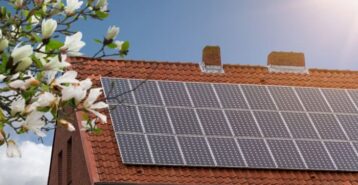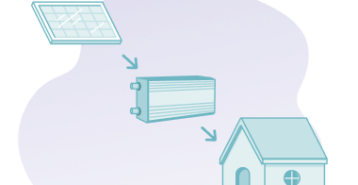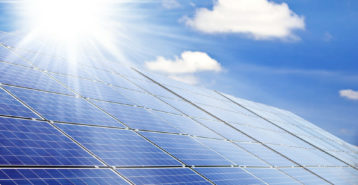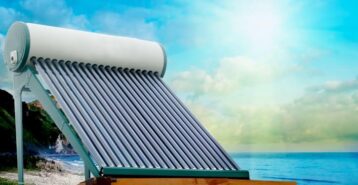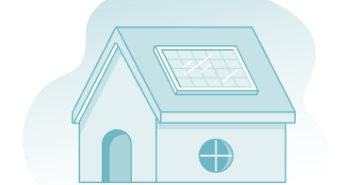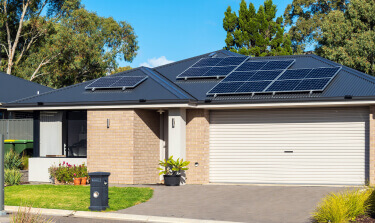What Are Solar Air Heaters?
Solar air heaters use the power of the sun to help heat your home and lower your utility bills. These systems work by converting sunlight into heat, which is then circulated through your home to create a warmer, more comfortable space. Best of all, solar air heaters are simple in design and can often be integrated with your current HVAC system, like a gas furnace or heat pump.
Benefits of Solar Air Heating
Solar air heating systems have several benefits, especially when compared to a gas furnace that uses fossil fuels.
1. Very Low Cost Energy Supply
Most homeowners will pay $1,000 or more each year to heat a home, depending on location. However, with a solar powered air heater, your heat energy supply is essentially free. You can replace your costly gas heating system with solar, or supplement it as needed.
The only ongoing cost of a solar air heater, if you choose an active system, is the small amount of electricity needed to run a fan. Even then, it’s minimal. In fact, solar air heaters are among the most budget-friendly solar energy options for homeowners.
2. Simple Installation and Maintenance
Another benefit of solar air heating is the simplicity of the system. You install the unit in your home by hooking up the lines and creating small holes in your wall, or attaching it to your windows. Then, you can enjoy heat produced nearly immediately.
Additionally, there are very few components of the heating system to maintain. The solar air heater consists of just a box with a couple of attached air hoses and, in certain cases, a fan. Systems usually work well for years after being installed, and the only real maintenance will be cleaning the glass over time to make sure sunlight is accessible.
3. Connects to Existing HVAC System
Solar air heaters can be added to your home’s existing central air setup in order to heat your entire home. This means you don’t have to pay to replace your existing heating and air conditioning system or layout. You can simply have the solar air heating system installed and enjoy lower utility costs.

How Do Solar Air Heaters Work?
A solar air heater is a straightforward system that operates much like a solar water heater. Sunlight passes through the glass front of an insulated box and hits a black absorber layer inside. This layer captures the sun’s energy and converts it into heat.
The box connects to two air hoses: One that pulls in cool air and another that pushes out the newly warmed air. As air flows through the system, it gets heated and then circulated into your home. For homes with larger heating needs, multiple solar collector boxes can be connected to boost heat production.
Do Solar Air Heaters Really Work?
Yes, solar air heaters absolutely work. They can be a cost-effective way to supplement your home’s heating. These systems absorb sunlight and convert it into heat, which is then circulated into your home using natural airflow or a fan-assisted setup. Even on cooler days, they can collect enough solar energy to warm your space efficiently.
Keep in mind that their performance depends on a few factors: The size of the system, the available sunlight, and how well your home retains heat. In the right conditions, solar air heaters can noticeably reduce your reliance on traditional heating systems and help lower your energy bills.
How Much Do Solar Air Heaters Cost?
The cost of a solar air heater depends on the size of the system, the space you need to heat, and the system’s overall capacity. Whether you’re looking to warm a single room or multiple areas in your home, there’s a solar air heater option that fits your budget.
Here’s a general breakdown of system costs before installation:
- Small or DIY Units: $70 to $300
Great for heating a small room or supplementing an existing system. - Mid-Range Residential Systems: $400 to $1,100
Ideal for heating one or two rooms, offering a balance of performance and affordability. - High-Capacity or Whole-Home Systems: $1,500 to $6,000
Designed to heat multiple large rooms or your entire home.
When you factor in installation, most homeowners pay between $900 and $5,000 in total. Smaller rooms typically fall at the lower end of this range, while heating several large spaces will increase your overall cost.
The good news? Solar air heaters offer a solid return on investment. Most homeowners recover their costs in 5 to 7 years through reduced utility bills. This is often quicker than traditional gas heating systems, which can take 6 to 15 years to deliver similar savings.
Ways to Utilize Solar-Powered Heating Systems
Passive Energy
A solar air heater can operate without a fan or electricity. These systems use natural airflow, also called passive solar heating, to move air through the unit and back into your home. As warm air rises out of the system, cooler air flows in to take its place, creating a natural circulation loop.
This makes passive solar heaters a great option for remote locations where electricity isn’t available. In these cases, solar panels or powered fans aren’t required for the system to function.
To work effectively, the heater must be set up with:
- An inlet at the bottom to draw in cooler air.
- An outlet at the top to release the warmed air.
This setup takes advantage of a basic principle of physics: warm air rises. As heated air exits the top, it naturally draws in more cool air from below, keeping the cycle going.
Some homeowners choose to boost performance with a solar-powered fan, especially during colder months or when trying to heat larger spaces. This hybrid setup can offer the best of both passive and active heating, depending on your seasonal needs.
Solar Heating Fan Assist & Active Direct Gain
While fan-free (passive) solar air heaters can effectively warm a small space, or even a larger room with multiple units, they typically fall short when it comes to heating larger rooms or entire homes. Without a fan, heat tends to collect near the unit, leaving some parts of the room noticeably cooler than others.
That’s where a fan-assisted, or active direct gain, system comes in. These systems use a temperature-controlled fan that activates when the internal temperature reaches a set point. The fan pulls in cool air and pushes out warm air, helping to circulate heat more evenly across the space.
Most setups use a single fan at the outlet to disperse heat. As warm air is pumped out, cooler air is automatically drawn into the inlet. This creates a continuous airflow that efficiently spreads warmth throughout your home.
Looking to heat larger areas or improve comfort across multiple rooms? An active fan-assisted solar air heater is often the best solution.
Installing a Solar Air Heater
Solar air heaters are relatively simple to install, and many homeowners choose to DIY this task. However, keep in mind that the solar collectors required can be large and heavy, as much as 4 feet wide and 7 feet tall. Solar air heating systems sometimes require a permit. Also, if they’re heavy enough, they need to be installed on the roof. This larger solar air heater project would require the work of a solar professional.
Are Solar Air Heaters Worth It?
For many homeowners, solar air heaters are a smart investment. This is especially true if you’re looking to cut heating costs or reduce your carbon footprint. They’re one of the most affordable solar upgrades. Many systems pay for themselves in five to seven years through energy savings. They’re also simple to install and require little maintenance, adding to their overall value.
They’re most worth it when used in well-insulated homes or as supplemental heat in rooms that get chilly in the colder months. If your home gets good sun exposure and you’re looking for a lower-cost solar option, a solar air heater could be a great fit.
Compare top-rated solar pros in your area.
Read real homeowner reviews, explore qualifications, and view promotions. Modernize makes it easy to browse professionals and find one that will be perfect for your project.



